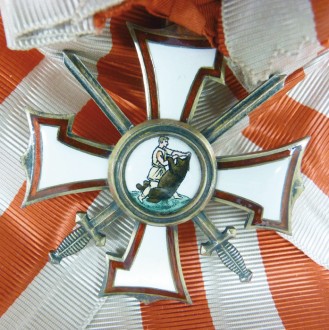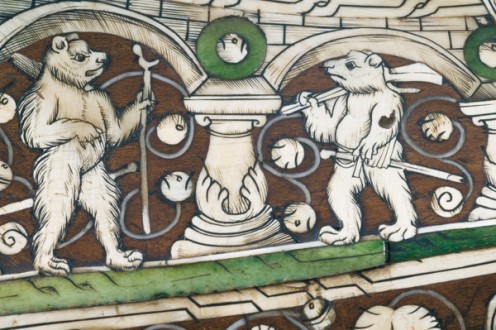
The Liberating War of 1914-1915. Symbolic map of Europe. By B. Crétée, printed by the éditions Delandre © Paris, musée de l’Armée
This map illustrates the political situation in 1914-1915 from the Russian point of view. The different nations are represented by national stereotypes or symbols. Czar Nicholas II occupies a prominent place, and in his empire bears and cubs are represented with two other animals. An allegory, holding the double-headed eagle Russian Imperial flag, seems to encourage the czar by leaning towards him, one hand resting on his shoulder. The czar proudly stabs the neck of the German bull who is charging France, portrayed by Marianne sided by an avenger cockerel.
This weapon, used for hunting and for war, is a precious object and a symbol of power to its owner. Ivory bears, standing and armed like men, decorate the butt of the musket. As in the fables of Aesop’s Fables or La Fontaine, “humanising” animal makes it possible to evoke men. © Paris, musée de l’Armée, Dist. RMN-GP / Tony Querrec
The Bear
The Absolute Warrior
For the longest time, the bear was considered as the incarnation of the king and the invincible warrior among the Celts, the Germans, the Balts, the Slavs, the Lapps, the Japanese … In Europe, he was believed to be the king of the beast, the totemic animal young men had to fight and kill during initiation rites in order to be admitted into the world of adult warriors. The fighter used his name, his canines, his claws or his hair as talismans for protection, to appropriate the strength of the animal and / or to scare his enemy. His image is also present on signs, weapons and armour.
Too Wild?
In his book, The Bear, the Story of a Fallen King (La librairie du XXIe siècle, Seuil, 2007), Michel Pastoureau reminds the reader that during the second century of our era, Pausanias (c. A.D. 110 – c. 180) wrote in his Graeciae Descriptio (The Description of Greece), in that in ancient times, the men from Arcadia, meaning bear from Greek Arktos, fought against the Spartans dressed in bear skins. Michel Pastoureau mentions that during a mission to Saxony in 742, Saint Boniface related to Daniel, then bishop of Winchester, that the “ritual of the pagans” consisted in dressing up as bears and drinking the blood of this animal before going to battle. The Western Church fought violently against the pagans’ fascination for the bear, for a very long time and succeeded in linking the animal to six of the seven Deadly Sins; the bear was only tolerated when presented to the public in popular fairs, chained and muzzled.
 Order of Lāčplēsis, also known as the Order of the Bear Slayer. This Latvian order was established in 1919 by general Jānis Balodis, Commander-in-Chief of the Armed Forces of Latvia. It owes its name to the Latvian national epic written between 1872 and 1887. The poem recounts the life of legendary medieval Latvian hero Lāčplēsis – meaning bear slayer in Latvian – who defended Latvia from the German invaders. The order features Lāčplēsis killing a bear with his bare hands. © Paris, musée de l’Armée
Order of Lāčplēsis, also known as the Order of the Bear Slayer. This Latvian order was established in 1919 by general Jānis Balodis, Commander-in-Chief of the Armed Forces of Latvia. It owes its name to the Latvian national epic written between 1872 and 1887. The poem recounts the life of legendary medieval Latvian hero Lāčplēsis – meaning bear slayer in Latvian – who defended Latvia from the German invaders. The order features Lāčplēsis killing a bear with his bare hands. © Paris, musée de l’Armée
A Caricature of the Russians
During the seventeenth century, as the Russia expanded eastward, the British ridiculed this thirst for conquest by caricaturing Russia as an imperialistic bear. By doing so, they opposed their own national emblem, the noble leopard to the barbaric and lazy bear that hibernates for months only to wake up unexpectedly and violently.
During the 1950’s, Soviet aircraft designer Andrei Tupolev designed his turboprop strategic bomber, the Tu-95. This strategic intercontinental heavy-payload bomber aircraft was used during the Cold War. In the NATO reporting names list, this gigantic aircraft – 46 m long, 50 m wide – is called “Bear” (B for bomber) or simply “Bear”. This aircraft is still in service in the Russian Air Force and Naval Aviation.
The NATO reporting names list is used by NATO members to name military equipment from the former Eastern Bloc – USSR and nations of the Warsaw Pact.




Ajouter un commentaire